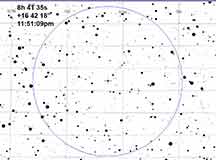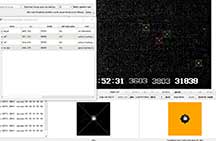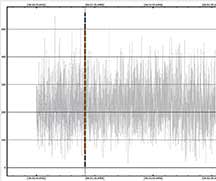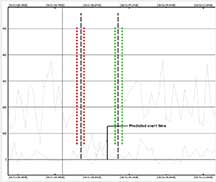


This is a nominally high rank event on a narrow path between Santa Cruz and the summit of the SC Mtns, so none of Team Santa Cruz has high odds of seeing it if they stay home, although Karl is closest. Instead, I am planning on a short trip to the big dirt parking area up Branciforte before Mtn View Drive. The altitude might be a little close to the ridge line but I think it's good. The RUWE is good. The prediction should be good (but, we've heard that before with these small asteroids. Sometimes they mis-behave).
Alt=28, Az=270 due west. Duration is 0.5s, bright enough you should use 2x if at all possible.
 |
 |
 |
I recorded from the steep upslope on Rodeo Gulch, about 100 yds above the intersection with Mtn View at St Clares Retreat. It has a good overlook, and It was a few minutes faster to get to as I was now running behind. I got out the door fairly efficiently, but then realized my gas tank as ~on empty. I stopped at the only gas station on my route, the Shell on Ocean St, but the kid in charge was not competent and it took some time to get 3 ga into my car. Then, off to Market St and Branciforte. I pulled over at the large empty parking spot I've used once before for an asteroid event. I'd done some trig with Google Earth and thought I could get the star just above a gap in the trees.... but on arrival, I lost my nerve, and it also seemed the trees may have grown since the GoogleEarth photos were taken. I got back in the car and drove up to the top of Mtn View, onto Rodeo Gulch, and when I saw the overlook I took it.
Set up went quick and efficiently, and my GoTo went perfectly to the target. I had to decide whether to go with 2x or 4x. At 4x, the target star was bright and consistent, at 2x is was almost lost in the noise. I worried that w/o adequate sampling, the auditors would reject even a valid occultation, so I stayed with 2x to get the extra sampling. As is turned out, this was a good choice, even though the target was so faint on the external monitor (never did unplug it) that I couldn't tell if there was an occultation.
PyMovie and PyOTE cleally found the 0.400 sec event, and it passed the 5-sigma FP test too. And, it was dead on the predicted time as well.
The no-star histogram was clearly clipped past the peak. So the No-Star light curve has a non-zero mean. It agrees nicely with the target star mid-occultation mean, marking true 'no target'.
magDrop report: percentDrop: 80.9 magDrop: 1.799 +/- 0.625 (0.95 ci)
DNR: 2.42
D time: [06:51:08.7208]
D: 0.6800 containment intervals: {+/- 0.0147} seconds
D: 0.9500 containment intervals: {+/- 0.0446} seconds
D: 0.9973 containment intervals: {+/- 0.1175} seconds
R time: [06:51:09.1208]
R: 0.6800 containment intervals: {+/- 0.0147} seconds
R: 0.9500 containment intervals: {+/- 0.0446} seconds
R: 0.9973 containment intervals: {+/- 0.1175} seconds
Duration (R - D): 0.4000 seconds
Duration: 0.6800 containment intervals: {+/- 0.0223} seconds
Duration: 0.9500 containment intervals: {+/- 0.0574} seconds
Duration: 0.9973 containment intervals: {+/- 0.1258} seconds
 |
 |
 |
 |
 |
 |
 |
Kirk observed from Scotts Valley and got a recording, will record here when ready.
Used 16x, at home, and a recording he thinks is a "miss". However at 16x, that's only 1 or 2 integrations that would show the occultation.
Observed from home, just ouside the northern 1-sigma line. He needed 16x to see the target well, and 8x was too faint. That's unnerving, that he needed that much integration to see the target, given that 2x was adequate for me and Kirk. Is his external monitor at fault?